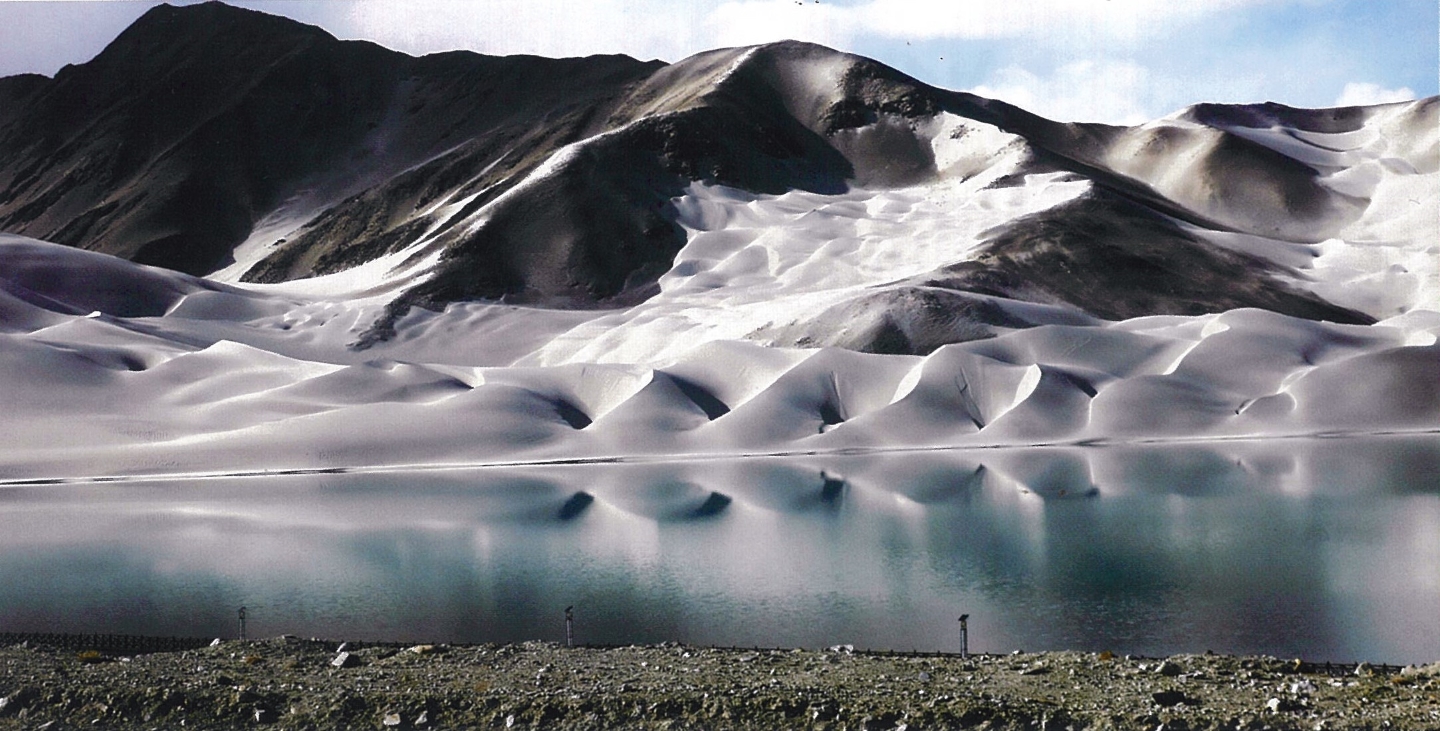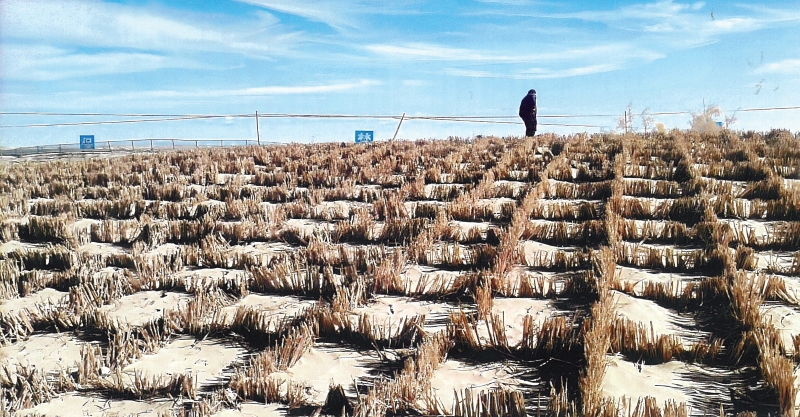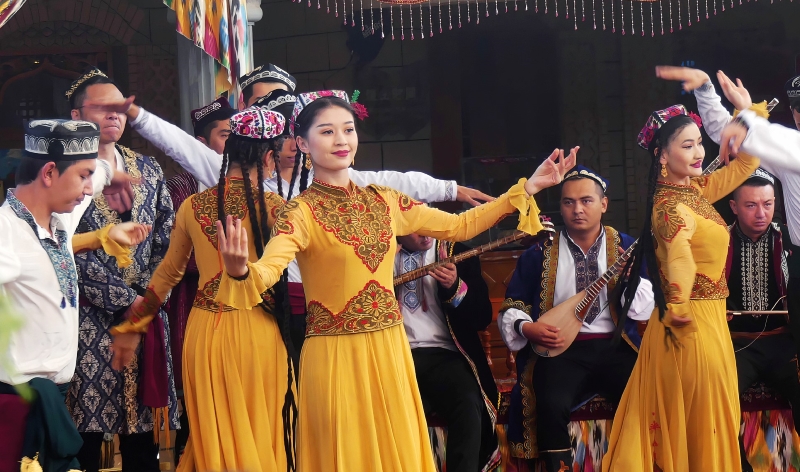
Karakul Lake is encompassed by mountain peaks that are snow-capped all year round (Photo: Lam Y K)
If you want to keep your friends, do not travel with them, people quip. However, 10 seniors, most of whom have known each other since their school or university days, set off for Southern Xinjiang last October and “became even closer” over the 12 days.
That trip has led to another, unplanned, “journey”. An old classmate, Lim Siang Jin, saw their many photos — each of them took about 1,000 shots — and suggested, “Why don’t you all have a show?” One thing led to another and Southern Xinjiang: Allure of Harmony in Diversity, opened in Kuala Lumpur on April 20.
The exhibition is a result of harmony and mutual trust, of knowing nobody would pull out — as with the Xinjiang expedition, Lam Yoong Koy says at the pre-opening at Jin’s Gallery, which is hosting the show, curated by Lim. With Lam are his wife Hen Yean Ni, as well as Leow Yuen Leong and Nathalie Fougere, all part of the tour.
Fellow travellers Chia Yong Tai, Choo Bee Ha, Tan Yeow Joo, Yeong Poh Choo, Yep Beng Hong and Yong Chai May also contributed to the 50-plus photos on display, and the 100 packed in a 64-page book that lends context to their work, with captions providing interesting details.
Besides serving as a record of their travels, the photos capture what is unique about their destination, plus the emotions, stories and everyday activities of its people, which make for fond memories of an unforgettable journey from Kashgar to Urumqi, capital of the Uygur Autonomous Region of Xinjiang.
exhibition_of_photos_on_southern_xinjiang_from_left_hen_yean_nilam_yoong_koy_nathalie_fougere_and_leow_yuen_leong.jpg

Why Southern Xinjiang (Chinese for “new borders”), where not many go?
“We wanted to see the beautiful poplar forests with their golden yellow colours,” Lam says. Most of the group had visited Northern Xinjiang in 2016 and were struck by its scenery. With that experience and some research, they drew up an itinerary for the local guide in China on what they wanted to see, do and taste this time around.
Breathtaking natural landscapes and the region’s rich cultural heritage were top of their list. After flying in to Chengdu, Sichuan Province, they began their 5,000km overland trip from the eastern Pamir Plateau along the China-Pakistan-Tajikistan border. On the way, they passed through ancient oasis towns, walked across dried-up river beds and were enchanted by the Taklamakan Desert and flaming Tarim Poplar Forest, before crossing the Tianshan Mountains to Urumqi.
With the oldest among them aged 75 and the youngest 62, there were some misgivings about tackling terrain that ranged from highlands to lowlands and wetlands. The weather was harsh and unpredictable too: Temperatures can suddenly dip, turning the nights freezing cold. Altitude is another issue, with winding roads leading to the foot of mountains where peaks rise thousands of metres above sea level. “Some of us were sick, but only for a short while,” Lam shares.
reed_checkerboard_page-0001.jpg

But the good things they encountered and experienced more than made up for that bad spell. Newly built highways connect the desert towns, which are abuzz with commerce and development, and wireless networks span the plateaus and the interior of the desert. The hotels are modern and fully equipped to meet guests’ every need: There are washing machines at your disposal or service staff will pick up dirty laundry from the room and return them cleaned the same day. Cashless transactions, a welcome convenience on the road, are the norm everywhere, at huge malls to bazaars and night markets.
For an hour along one highway, their bus drove past expansive solar panel fields and wind farms that harness power to generate clean renewable energy. They noticed orchards and farmlands thriving in the different topographical regions, helped by the continental arid climate and fertile soil.
The group specifically asked to try local fare and gamely tucked into culinary delicacies brought to Xinjiang on the Silk Road, some of which have amalgamated with dishes from the region. Meals are often 10-course affairs at multi-storey restaurants where each level offers a different kind of food.
Mosques built centuries ago stand tall in Kashgar, which is steeped in Islamic culture. The ruins of a stone fortress evoke images of temples and monks bent over scriptures. At the Han-style Gengong Shrine in the Old City, which has a history of over 2,000 years, a bronze statue of a soldier astride his steed reflects a different people and culture.
The Uyghur Muqam, which encompasses sung poems, instrumental pieces and diverse dance rhythms, is recognised by Unesco as part of the Intangible Heritage of Humanity. Another heritage asset is Etles silk, a traditional fabric woven from Atlas moth silk and worn during festive occasions.
mock_wedding_ceremony.jpg

Asked what he took home from Xinjiang, Leow says some myths were “busted” after he saw the place for himself. “The people have maintained their own culture.” A photo he took of a century-old teahouse where musicians sang lively Uyghur folk songs, accompanied by traditional instruments, emphasises that point.
With Covid under control, China is encouraging local tourism and everywhere the group went, they met like-minded visitors from cities like Hong Kong, Guangzhou and Heilongjiang, lured by the region’s scenic beauty, culture and food. Hen chatted with one merry party that was willing to talk and was comfortable doing so. Schoolchildren she spoke to, in Mandarin, were confident and the babies they saw were plump and happy. “If you want, you can easily make friends in Xinjiang,” she thinks.
Fougere felt a sense of safety during her visit. “The kids play on the road and the old come out to meet friends. It could be a model of a place where people respect each other and go about their lives without too much conflict or problems.”
The best season to visit Xinjiang depends on what you want to see, Lam says when asked. Go in April for the flowers and June/July for the fruits. If mysterious canyons, wind-carved rocks, caves and forest parks call out to you, autumn is ideal. Of course, being in a place where harmony and diversity thrive with good pals makes everything more meaningful.
'Southern Xinjiang: Allure of Harmony in Diversity' is on until May 12 at Jin’s Art Gallery, A-3-17, Centrio Pantai Hillpark, 1 Jalan Pantai Murni, KL. Open only on Saturday and Sunday. For enquiries, call (019) 221 9680.
This article first appeared on Apr 29, 2024 in The Edge Malaysia.


